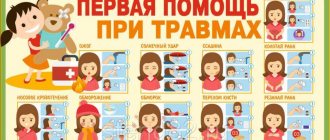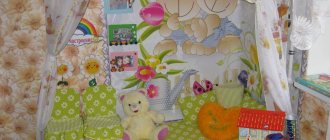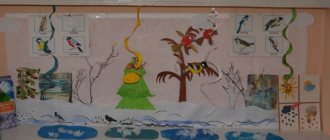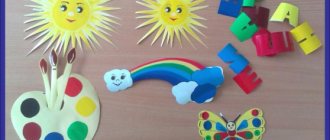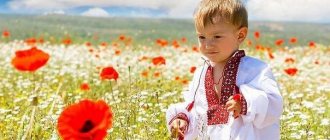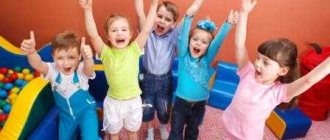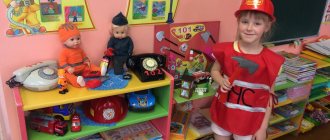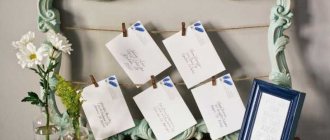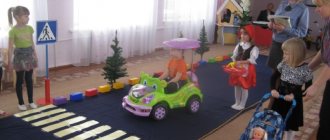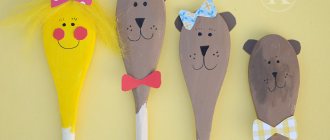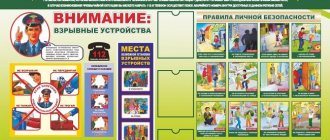The relevance of logical and mathematical zones in preschool institutions
The rapid development of science and high technology these days requires educational institutions to take a new approach to teaching the younger generation. They should not only equip children with knowledge and skills, but also develop life competencies, without which it is impossible to become successful and in demand in the modern world:
This work begins in preschool educational institutions (DOU). Modern exemplary educational programs proclaim one of the most important tasks of a preschool institution is the formation of a comprehensively developed, creative individual striving for active knowledge of the world around him. An important component of the comprehensive development of a child is logical and mathematical. And, in turn, zones of logical and mathematical development (mathematical corners) are a necessary part of the general developmental environment in a preschool educational institution.
Tasks of organizing mathematical corners
In early kindergarten groups, they organize not mathematics corners, but sensorimotor zones, equipment that introduces children to the color, shape, size of objects, promotes the development of fine and gross motor skills, spatial orientation, but does not concern the actual mathematical concepts and operations, such as quantity, comparison of objects in a group, formation of sets, etc.
Math corners are set up in groups for children four years of age and older. The purpose of their creation is to stimulate the cognitive activity of children and encourage them to engage in a variety of activities in the field of mastering mathematical concepts, skills, and abilities in accordance with their age-related psychophysiological characteristics.
The objectives of organizing a math corner in a kindergarten group:
- Enrich the group’s developmental environment with materials and equipment aimed at developing mathematical concepts. Developing children's thinking is no less important than promoting their physical or speech development.
- Organize work on developing children’s mathematical understanding. By collecting all the games in one place, systematizing manuals and literature on mathematics, the teacher has the opportunity to carry out targeted work with children and share experience with colleagues, which contributes to the further replenishment and improvement of the group’s developmental environment. In addition, the teacher sees what materials are sufficient in the corner, and what needs to be made and updated. If games and equipment are stored in different places, unsystematically, it is much more difficult to keep track of them and replenish them in a timely manner.
- To increase children's interest in engaging in a variety of activities related to mathematics. Bright, entertaining filling of the corner will certainly attract the attention of even those children who do not show interest in organized activities in FEMP, and will allow them to develop their mathematical abilities gradually, indirectly: for example, if a child likes to draw, then he can be asked to decorate an image of a house, a fish, tree, made up of geometric shapes, naming each figure (“Now let’s color this triangle - the roof. What color will it be?”) or “revive” the silhouette of the number (“This two looks like a duck, you just need to finish drawing its beak, eyes and paws"). Some children grasp much faster information that is presented not as main, but as secondary, which is used during creative and playful activities in the mathematics corner.
- To promote the development of gifted children, to satisfy their increased need to learn new things. To do this, the mathematics corner should contain materials that are “ahead” of the students’ age. For example, in the middle group, where children, according to the program, are introduced to numbers from 1 to 5, you can place cards with entertaining images of the numbers 0, 6–9, which will certainly interest the most inquisitive “mathematicians.” The teacher should explain to those children who show interest what these numbers are, how many objects they correspond to (mathematical puzzles, lotto will help here), praise the children for their attentiveness and inquisitiveness. In the senior group, the advanced development of pupils will be facilitated by a selection of logical exercises: joke problems, intelligence exercises, memory and attention development, as well as all kinds of puzzles.
- To encourage children to develop a need not only for activities with toys, fun, and entertainment, but also for games where they need to show their thinking abilities, intelligence, and reveal the meaning of such games: to achieve victory, to become the first thanks to their knowledge, intelligence, and ingenuity.
- Develop the ability to organize your free time, choose an activity based on your interests, engage in your favorite activity with friends, help them master skills (lay out a pattern of figures, sequence, correlate a number and a number).
- Develop thought processes, intelligence, resourcefulness, cultivate independence, organization and even courage. Sometimes timid, indecisive children do not answer in class because they are afraid of making mistakes and are unsure of themselves. In a mathematical game, they express themselves and give the teacher the opportunity to evaluate their real knowledge and skills. Having answered correctly during the game, having received the support of the teacher and friends, preschoolers (especially older ones) often get rid of the fear of being ridiculed for making a mistake and begin to behave actively in class.
You can also master new knowledge in an exciting mathematical game together with a teacher.
What should be in a nature corner in kindergarten?
In addition, in a corner of nature in each group it is necessary to have:
- Natural vegetables and fruits, or their dummies.
- Sets of pictures depicting animals, birds, insects and more.
- Albums "Seasons"; books with illustrations depicting animals; paintings by famous artists.
Interesting materials:
What is AWD? How can I find out my bank account? Bashneft how to calculate bonuses? Bdds what? Bdr and bdds what? What does running give you? What is white matter responsible for in the brain? Without socks or socks, which is correct? Binary options how to trade correctly? How are sick leave paid?
Requirements for organizing a math corner
When creating a mathematics corner in a group, the teacher first of all thinks through where it will be located, what it will consist of, what it is filled with and how it is decorated in order to arouse the interest of the children and harmonize with the overall design of the group. The main thing you need to pay attention to is the general requirements for the development environment of a preschool educational institution:
- Safety and health of children. The equipment and materials of the corner should not contain objects that are potentially dangerous for children (too small, sharp, etc.). Therefore, buttons, beans and other similar material for counting and recalculating by touch should be stored in tightly tied or sewn bags so that children cannot get them out on their own and use them for other purposes. It is permissible to use such items without reliable packaging only under the strict supervision of a teacher.
- Instead of hard plastic geometric shapes (triangles, squares), it is better to use soft plastic or cardboard ones, since their corners will not harm children.
- Shelves, racks for toys and games must be securely fastened and located at the children’s eye level, so that students do not have to reach for materials, much less stand on chairs to get them.
- The corner should be located in such a place that it is well lit, and the tables and chairs at which games and other activities will be held should correspond to the height of the children.
- Children should be able to not only see the number of objects in the picture and correlate it with a certain number, but also independently make sets of small toys, natural materials (chestnuts, pebbles, pine cones), divide them into smaller ones, and combine them into one.
All corner equipment is positioned so that children can use it comfortably
Preschoolers should be taught to always put materials and manuals back in place after games, and encourage those who do this without a reminder, on their own initiative.
Mathematics Corner Passport
So that all the equipment and materials of the corner are taken into account, and the teacher can outline what else should be made, which area to pay special attention to, a passport of the mathematical corner is maintained.
DIY math corner in kindergarten.
November 27, 2015 The preschool institution summed up the results of the “Entertaining Mathematics” competition
In order to intensify the creative activity of teachers to create conditions for the mathematical development of children, a review competition “Entertaining Mathematics” was held in our kindergarten. Teachers were asked to organize it using a group play space, ensuring free access for children to the materials located there. This will provide children with the opportunity, in their free time from educational activities, to choose a game that interests them, a manual of mathematical content, and play individually or together with other children, in a small subgroup. The creation of corners was preceded by consultations with specialists on the topics: “The use of educational games for the cognitive and mathematical development of pupils in implementation of the Federal State Educational Standard for Preschool Education,” which helped teachers select game materials and implement ideas for designing math centers. 10 groups took part in the competition.
The jury assessed the following criteria:
-competence in the selection of games and manuals, their diversity;
- appropriate for the age of children;
-novelty and originality of the presented materials, focus on the mental development of children;
- compliance of the objectives of the instructions with the content of the games, accessibility of presentation;
-compliance with sanitary and hygienic standards and safety requirements;
-participation of parents in the production of games.
During the preparation for the show, teachers showed creativity, implemented original ideas, and involved parents in the design process.
In the first junior groups, teachers presented a wide variety of materials to develop students’ ideas about the size and shape of objects. All material is aesthetic, attractive to children, and appropriate for the given age. In the first junior group “A”, teachers are Alekseeva A.N., Tarabanko A.A. a development center was identified in the form of a mathematical palm tree, decorated with toys of various shapes made from threads. Teacher I.A. Chasovnikova showed imagination and creativity when selecting and equipping the center. Teachers of the second junior group “A” Shulgina V.K. Ushakova L.P. presented material on all sections of the program: quantity, shapes, size, orientation in space, etc., parents of pupils of the second junior group took an active part in equipping the subject-spatial environment.
Teachers Luneva S.N. Gorina N.A. - middle group “A” was designed in the form of a multifunctional wall panel, this design helps teachers save group space. Work in this center involves children playing with a teaching house, helping to consolidate orientation in space; while playing, the child learns to count, gets acquainted with the quantity and number of objects. Koval G.K. Korobkova Yu.Yu. - teachers of the middle group “B” created optimal conditions in the group for the development of cognitive and mathematical abilities. Teachers made a large number of manuals and games with their own hands; these games are easy to use, aesthetically pleasing and easy to make.
Teachers of senior groups Nesterova M.V. Shurygina N.K. Evseenko O, P. managed to equip the subject-spatial environment for mathematical development. The math corner is located in the study area. It contains games with ready-made content, a card index of games according to the ages of children: “Connect the dots”, “Mathematical carpet”, “Counting ladder”, lotto “Learning numbers”, “Geometric shapes”, “More - less”, cubes for learning numbers , flowers, geometric shapes, geokont games, Nikitin cubes, Columbus egg, tangram, Dienesh blocks, etc.
Preparatory groups teachers Mozheiko T.N. Rybakalnikova V.G. Korobkova Yu.Yu. selected material for all sections, the equipment of the mathematical center is distinguished by a wide variety of didactic and developmental material.
Based on the results, the following winners were determined:
1st place - middle "B" group, first junior group "B"
2nd place - middle group “A”, preparatory group “B”
3rd place - senior group B”, Fireflies”, second junior group “A”.
Congratulations to the winners and thanks to all participants of the competition for their creative activity and demonstrated skill
We are confident that our children will develop and easily cope with any mathematical problems!
Educational and methodological material in mathematics (senior group) on the topic: Math corner in the senior group “Entertaining mathematics”.
Goal: to promote the development of logical and mathematical thinking, the development of cognitive activity, the desire for independent knowledge and reflection.
Objectives of the math corner:
1. Developing the ability to independently apply material in order to master mathematical knowledge, actively participate in individual or group games, help a peer if necessary, talk freely with adults about games and mathematical materials, and practical tasks.
2. Purposeful formation in children of interest in elementary mathematical activities, the development of qualities and personality traits of the child necessary for successful mastery of mathematics in the future, the desire to achieve a positive result.
3. Development of the ability to generalize, compare, identify and establish patterns, connections and relationships, solve problems, put forward them, anticipate the result and course of the solution.
Relevance:
Children have an increased need for cognitive activity, interest in the mathematical world, and a desire to learn new things.
A math corner is a specially designated place, thematically equipped with games, manuals, and materials. We placed it near the window, in a lit area of the group space.
By creating a math corner, we provided children with free access to materials and games. This gives children the opportunity in their free time to choose a game, benefits, etc. that interests them, to play individually or together with other children.
Math corner capacity:
In the math corner there is a carpet, a board for working with chalk, a magnetic board, a cash register of numbers, and sets of cards.
The math corner also includes:
Mathematical logic, educational and intellectual games:
“Columbus Egg”, “Geokont”, “Tangram”, “Dienesh Logic Blocks”, “Cuisenaire Sticks”, “Voskobovich Squares”, “Magic Square”, “Labyrinths”, etc.
Handout:
Flat – sets of geometric shapes, insects, animals, flowers, berries, mushrooms, Cuisenaire sticks, Dienesh blocks, numbers, signs, stripes, rulers.
Volumetric - vegetables, fruits, counting sticks, scales, fans, geometric shapes, animals.
Didactic games with visual material, familiar to children from classes:
“Find according to the diagram”, “What figures are missing”, “Hurry up, don’t make a mistake”, “Find the extra”, “Snow White’s Journey”, “There are many examples, but there is only one answer”, “Build a path”, “Highway”, “ Miracle - tree”, “Plant a garden”, “Angle”, “Temperature”, “Replace the number”, “Compare houses”, “Guess what is where”, “Volume”, etc.
There are a total of 37 didactic games in the group.
Didactic aids:
models, diagrams, graphs, drawings, maps, mathematical notebooks, mathematical constructor and other manuals with mathematical content.
Board-printed and educational games:
“Mosaic”, “Pick up a pattern”, “Funny little train”, various types of “Lotto” (numbers, geometric shapes, flowers, animals, seasons, vegetables, fruits, cars, food, toys, etc.), “Big – small”, “Parts of the whole”, “Home corner”, “Correspondences”, “Caterpillar”, “Shapes”, “Associations” (seasons, sports, figures and shapes, colors, sizes, find a pair).
Materials for individual development:
cards, Rubik's cube, logic snakes, abacus, puzzles, lotto, dominoes, adding machines, checkers, chess.
Coloring pages:
“Draw by cells”, “Connect by dots”, “Labyrinths”, “Make a picture”, various mathematical coloring books.
Math fun:
riddles, joke problems, puzzles, crosswords, puzzle games.
Literature for children with mathematical content:
mathematical fairy tales, verbal tasks.
Card index of games (with descriptions), consultations for parents.
Demo material:
1) Clock (flat, voluminous, with numbers, with moving hands), hourglass.
2)Material for carpet: animals, wood, numbers, fruits, vegetables, geometric shapes, etc.
3)Various math posters.
4) Books for children on mathematics;
We showed the math corner
We told you a little about ourselves.
And we will visit you, we will wait for you,
We have more to show!
Requirements for organizing a corner according to Federal State Educational Standards
In order for the mathematics corner to fully comply with federal state educational standards, you need to remember a number of factors at once.
Safety and protection of child's life:
- The material equipment of the corner should not contain any items potentially hazardous to life and health (pea seeds, beans, buttons, beads, etc.). If bags, for example, with beans, are needed for the development of fine motor skills, then they must be tightly tied or sewn up, and work with them must be carried out strictly under the supervision of a teacher;
- Do not use geometric shapes made of hard plastic. The child may be injured by their corners. You should choose either soft plastic or cardboard;
- The places where toys are stored should be at the child's eye level so that he does not need to reach for them or stand on a chair. All shelves must be firmly attached to the wall;
- The corner should be in a well-lit place. There should be tables and chairs nearby where mathematical games will be played. They must match the height of the children.
Accessibility and age-appropriateness of the group. All materials must be selected based on this criterion. You can take an additional three or four games for advanced development from tasks for older ages.
One of the criteria for designing a math corner according to the Federal State Educational Standard is the diversity of its content. The games contained in it must cover all those areas that are considered within the framework of the FEMP program.
The connection between mental, practical and experimental activities:
- in accordance with the standard, children should not only be able to see the number in the picture and correlate the number of drawn objects with it, but also, with the help of natural material, independently add this number, decompose it into parts, and perform other actions that interest them;
- It is important to have a wide selection of geometric materials so that children gain a complete understanding of the shape and properties of shapes.
In the mathematics corner, all conditions must be created for creative self-expression and development of children. There should be materials for modeling, geometric coloring books, even counting sticks, which children love so much. Everything is limited only by the teacher’s imagination.
Important!
From the first day, it is necessary to teach children to clean up after themselves, put everything neatly on shelves, and put it in its place. This will help avoid clutter in the corner and teach “little mathematicians” discipline and responsibility.
